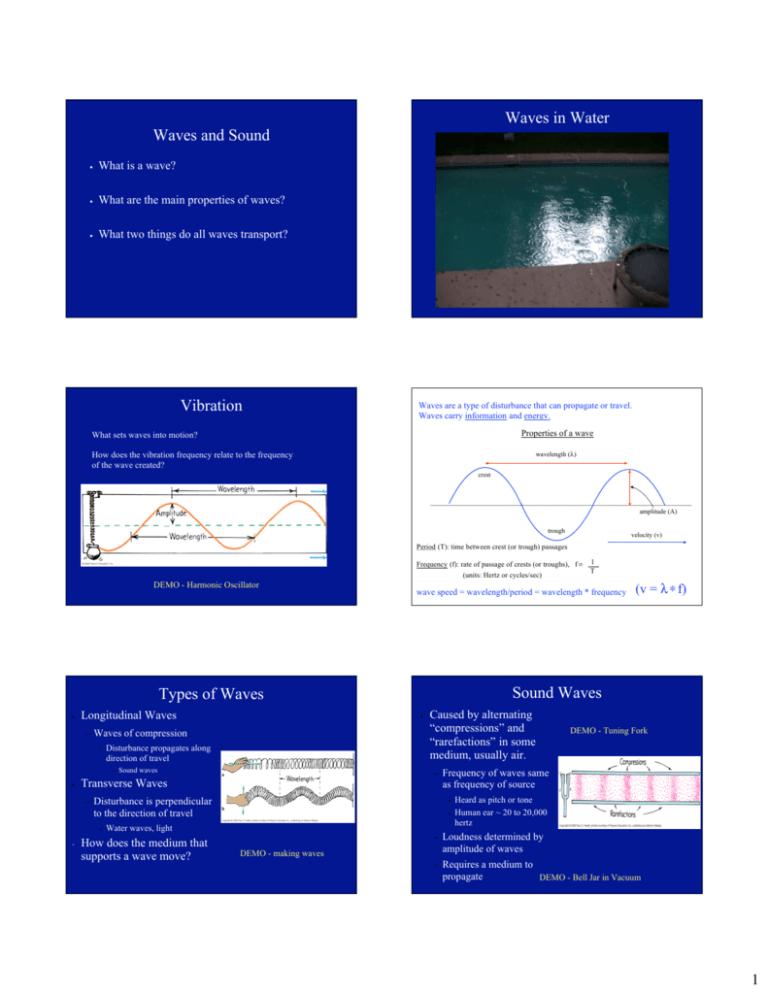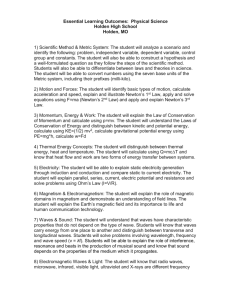Waves in Water Waves and Sound
advertisement

Waves in Water Waves and Sound ● What is a wave? ● What are the main properties of waves? ● What two things do all waves transport? Vibration Waves are a type of disturbance that can propagate or travel. Waves carry information and energy. Properties of a wave What sets waves into motion? How does the vibration frequency relate to the frequency of the wave created? wavelength (λ) crest amplitude (A) trough velocity (v) Period (T): time between crest (or trough) passages Frequency (f): rate of passage of crests (or troughs), f = (units: Hertz or cycles/sec) DEMO - Harmonic Oscillator wave speed = wavelength/period = wavelength * frequency Longitudinal Waves – ● Disturbance propagates along direction of travel – ● Sound waves Caused by alternating “compressions” and “rarefactions” in some medium, usually air. – Transverse Waves – Disturbance is perpendicular to the direction of travel ● ● ● Waves of compression DEMO - Tuning Fork Frequency of waves same as frequency of source ● ● Water waves, light How does the medium that supports a wave move? (v = λ ∗ f) Sound Waves Types of Waves ● 1 T Heard as pitch or tone Human ear ~ 20 to 20,000 hertz – Loudness determined by amplitude of waves – Requires a medium to propagate DEMO - Bell Jar in Vacuum DEMO - making waves 1 Speed of Sound ● ● Clicker Question: In dry air at 0 C, sound travels at 330 m/s (740 mph) – travels faster through warm air – travels faster through dense air Suppose the sound from a 50-Hz razor spreads out at 340 m/s. The frequency is: A: 20 Hz In water, sound travels at about 1300 m/s (3000 mph) B: 25 Hz C: 50 Hz D: 200 Hz Clicker Question: Clicker Question: Suppose the sound from a 50-Hz razor spreads out at 340 m/s. The period is: Suppose the sound from a 50-Hz razor spreads out at 350 m/s. The wavelength is: A: 0.02 seconds A: 1 m B: 2 seconds B: 7 m C: 20 seconds C: 50 m D: 50 seconds D: 350 m Resonance ● Any elastic object will vibrate at its own set of frequencies when disturbed – ● ● Determined by elasticity and shape Bells, violin strings, idling cars Resonance – ● Called natural frequencies ● Dramatic increase in amplitude when frequency of forced vibrations matches natural frequency of object ● Tacoma Narrows Bridge Resonance occurs when compressions and rarefactions are timed to the natural frequency of the tuning fork. Wind blowing through bridge induced a resonant vibration at ~0.2 Hz, (both longitudinal waves, and then fatally, torsional vibration) Tacoma Narrows Bridge Collapse on November 7, 1940 link to more footage Pumping a swing 2 Reflection & Transmission of Waves Waves bend when they pass through material of different densities. ● air water swimming pool SONAR – Used by Dolphins – Ships ● Ultrasound ● Earthquakes prism glass air air Diffraction ● Interference Waves will diffract at edges ● Constructive interference – When the peaks of two waves coincide ● Amplitude increases – web link ● – Interference ● Constructive interference – When the peaks of two waves coincide ● Amplitude increases – ● Ex. Sonic Boom Destructive interference When the peak of one wave “fills in” the trough of another Interference ● Constructive interference – Waves from the same object can add up when the velocity of an object making waves exceeds the speed of the waves Ex. Sonic Boom Destructive interference – When the peak of one wave “fills in” the trough of another ● Waves cancel – Ex. Noise Cancellation 3 Interference ● Constructive interference - Bow shock Interference ● Constructive interference - Bow shock Interference ● Constructive interference - Bow shock Standing Waves ● Constructive interference – When the peaks of reflected waves coincide – Nodal points don’t move DEMO - Standing waves Spitzer infrared telescope Shock Waves ● Sonic Boom ● Bow Waves Noise vs Music Noise 4 Fourier Analysis Sound Intensity dB = decibel, factor of 100 = 20 dB The Doppler Effect ● ● ● The frequency or wavelength of a wave depends on the relative motion of the source and the observer. (Shockwave Demo) (Web Link) How does the pitch or tone of a sound wave change when the source of the sound is moving towards or away from you? What about when you are moving towards or away from the source? Does this effect occur for all types of waves or just for sound waves? DEMO - Doppler Arm Clicker Question: For visible light, the frequency (or wavelength) determines its color. Clicker Question: True or False? Due to diffraction, at long wavelengths it is possible to see around corners. Compared to the sound it makes when at rest, a siren approaching us rapidly will : A: True B: have a louder sound B: False C: have a higher frequency A: have a longer wavelength D: have a longer period 5 Clicker Question: The Tacoma-Narrows bridge was destroyed by : A: hurricane force winds B: strong winds that resonated with the natural frequency of the bridge. C: overloading the maximum weight that the bridge could support on a windy day. D: thermal expansion on an unusually warm day in November. 6







